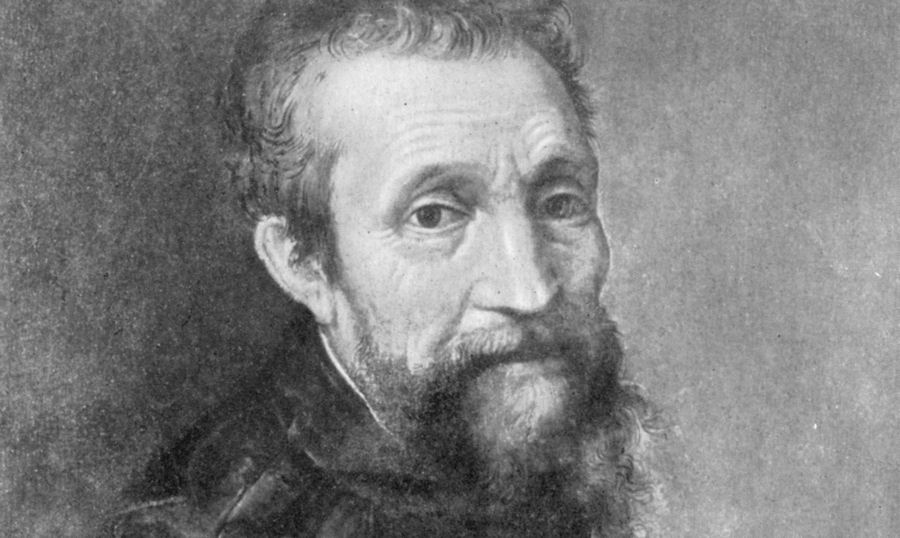
“There is no greater harm than that of time wasted.” – Michelangelo
Podcast: Play in new window | Download
Subscribe: Spotify | Amazon Music | Youtube Music | RSS
Michelangelo di Lodovico Buonarroti Simoni was born on 6 March 1475 in the village of Caprese, which is in Tuscany, Italy, approximately 100km to the east of Florence. His family was in the banking business and so while not affluent, they certainly weren’t poor. His father, Leonardo, was also a magistrate in Caprese. He and his wife Francesca Neri had five sons, of which Michelangelo was the second, and shortly after he was born, the family moved back to their home city of Florence. During this period, though, his mother became ill and so Michelangelo stayed for a while with a family of stonecutters.
Michelangelo attended grammar school in Florence but academic study was not high on his list of interests and he soon became interested in watching what the local painters and sculptors were doing. His father too realised that his second son would not follow in his footsteps to enter the finance business and so he arranged for him to be apprenticed to Domenico Ghirlandaio a well known Florentine painter when Michelangelo was still only thirteen years old.
In 1489, only a year after starting his apprenticeship, Ghirlandaio arranged for him to spend time at the palace of Florence’s Medici ruler Lorenzo the Magnificent, in order for him to study the sculptures in the palace’s gardens. This was an extraordinary opportunity for Michelangelo as it gave him access to not only the sculptures but also to the elite ruling class of Florence as well as poets, painters, and sculptors. He also studied anatomy and had direct access to cadavers to help him, which is more than likely what led to Michelangelo’s sculpting style which includes incredible detail of the musculature of the human body.
After Lorenzo’s death in 1492, Florence was thrown into political turmoil and so Michelangelo fled 100km north to the city of Bologna, where he continued his studies. He returned to Florence to begin work as a sculptor three years later.
After selling one of his sculptures to Cardinal Riario of San Giorgio he found the Cardinal to be so impressed with his work that he was invited to Rome which is where Michelangelo made his home and would live and work for the rest of his life.
While in Rome and still at the age of only twenty-five, he created one of his first masterpieces. Commissioned by a representative of King Charles VIII of France, Cardinal Jean Bilheres de Lagraulas, the Pieta, a sculpture of Mary holding the dead body of Jesus is carved from a single piece of marble and the lifelikeness of the work is still astonishing today. It is currently housed in a position of prominence at St. Peter’s Basilica in Vatican City. It is also the only work which bears Michelangelo’s name as he signed it after overhearing people claiming it was a work by another sculptor.
Michelangelo was now starting to become a bit of a star in the world of art and was commissioned by the new Pope Julius II to build him a tomb, which was designed to consist of 40 statues. Excited at the prospect of such a huge undertaking, Michelangelo spent eight months quarrying the marble, only to find that when he returned to Rome to start work, the Pope had lost interest and had turned his attention to a rebuild of St. Peter’s church. Frustrated, Michelangelo left Rome for Florence.
Whilst there, between 1501 and 1504, Michelangelo created his next great masterpiece that would become one of the enduring symbols of Florence. Now considered to be probably the world’s greatest sculpture, Michelangelo’s David is a nude statue of the biblical hero David which stands seventeen feet tall. It can currently be seen in the Galleria dell’Accademia in Florence, Italy.
Pope Julius had not finished with Michelangelo though and had him returned to Rome, where he was required to turn his attention away from sculpting and towards painting when he asked him to decorate the ceiling of the Sistine Chapel. The work, which contains over 300 figures was completed by Michelangelo alone after he fired all of his assistants, who he said were inept. The completed work was unveiled in October 1512. Spending eight years on his back at the top of scaffolding painting the ceiling took its toll on Michelangelo though and so while he continued sculpting and painting throughout his life, he turned most of his attention to architecture, working for decades on the tomb of Pope Julius II. He was responsible for a number of other buildings too, but the pinnacle of his career came in 1546 when he was asked to design St. Peter’s Basilica, but unfortunately, this would not be completed during his lifetime.
Michelangelo became wealthy and famous and even had two biographies written about him while he was still alive, but he did not flaunt his wealth, preferring to live a simple life and often putting his health at risk due to not eating properly and living in squalor as he got lost in his work.
In later life, Michelangelo wrote quite a number of poems and sonnets. Over 300 of these were written about and to a widow called Vittoria Colonna, the Marchioness of Pescara. He never married and was known to have a quick temper, was often melancholy and was also a recluse which led to him having few friends, but he was devoted to Vittoria until her death in 1547 and she remained the only woman he had a special relationship with right up until his death.
On 18 February 1564 at his home in Rome at the age of 88, just three weeks shy of his 89th birthday and after a brief illness, Michelangelo died. Following his last request, the legendary sculptor and artist’s body was taken by his nephew and he was interred at the Basilica of Santa Croce, the principal Franciscan church in Michelangelo’s beloved city of Florence, Italy.
Podcast: Play in new window | Download
Subscribe: Spotify | Amazon Music | Youtube Music | RSS




